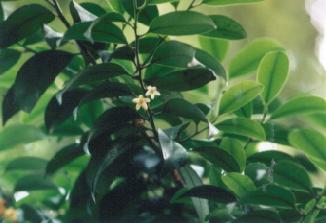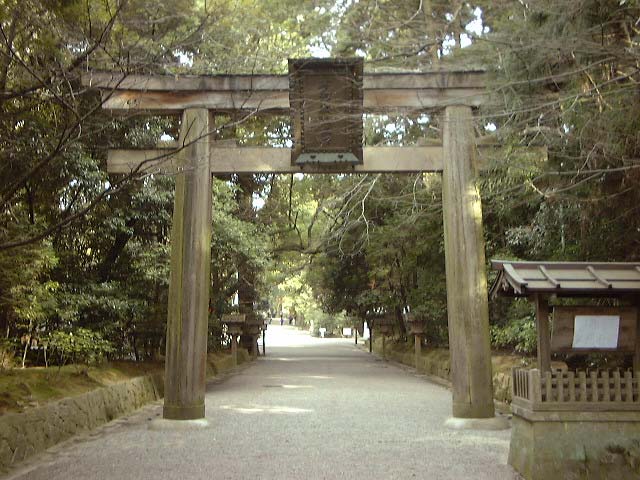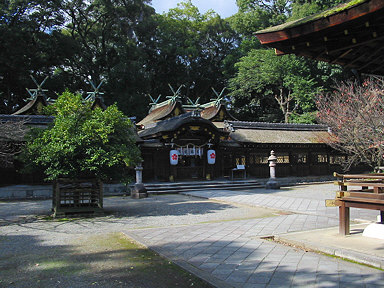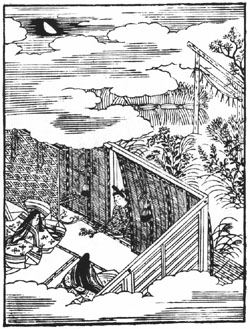
|
Japanese Aesthetics and
Liya Li Department of English SUNY/Rockland Community College (We recommend saving this file to your computer instead of immediately opening it in your web browser: right click on the link, select "Save Target As," save the file as a "Microsoft PowerPoint Slide Show" or .ppt file.) |
Using an excerpt from the chapter “The Sacred Tree,” this unit offers a guide to a close examination of Japanese aesthetics in The Tale of Genji (ca.1010). This two-session lesson plan can be used in World Literature courses or any course that teaches components of Zen Buddhism or Japanese aesthetics (e.g. Introduction to Buddhism, the History of Buddhism, Philosophy, Japanese History, Asian Literature, or World Religion).
Specifically, the lesson plan aims at helping students develop a deeper appreciation for both the novel and important concepts of Japanese aesthetics. Over the centuries since its composition, Genj i has been read through the lenses of some of the following terms, which are explored in this unit:
- miyabi (“courtly elegance”; refers to the aristocracy's privileging of a refined aesthetic sensibility and an indirectness of expression)
- mono no aware (the “poignant beauty of things;” describes a cultivated sensitivity to the ineluctable transience of the world)
- wabi-sabi ( wabi can be translated as “rustic beauty” and sabi as “desolate beauty;” the qualities usually associated with wabi and sabi are austerity, imperfection, and a palpable sense of the passage of time.
- yûgen (an emotion, a sentiment, or a mood so subtle and profoundly elegant that it is beyond what words can describe)
For further explanation of these concepts, see the unit “Buddhism and Japanese Aesthetics.”
Synopsis of The Tale of Genji
Acclaimed as the first psychological novel in the world, The Tale of Genji gives a vivid account of the court life of the aristocracy of Heian Japan (794 - 1185). (For more background information on Heian Japan , see section II of the unit “Women's Voices in Pre-modern East Asian Literature.”) The tale is divided into 54 episodes (chapters), and is related in the voice of a scribe-narrator who has witnessed most of the events portrayed, or has learned of them through hearsay. The original language in which the tale is written allows for the narrator's voice to vary from that of an omniscient narrator who is able to enter into the minds of characters and reveal their innermost thoughts to that of a lady-in-waiting in Genji's household. The tale relates with lyricism and understated drama the amorous impulses and political intrigues of Genji, the gifted and charismatic son of an emperor, and of Genji's descendents. It also depicts with a considerable degree of realism what life was like for the powerful elites of Heian nobility. In addition to touching upon the general human experience of love, marriage, sexual politics, suffering, death and so on, The Tale of Genji particularly reveals the influence of Buddhism on Japanese views, thoughts, and expressions of beauty (aesthetics). Thus, an awareness and understanding of such concepts as mono no aware , wabi-sabi , and yûgen is necessary for a more educated appreciation of this remarkable work.
For a detailed introduction to MURASAKI Shikibu, author of The Tale of Genji , as well as selected chapters from the novel, including “The Sacred Tree,” please refer to The Longman Anthology of World Literature, Volume B: The Medieval Era , Ed. David DAMROSCH et al. (New York, NY: Pearson Longman, 2004), pp. 222-224 for the intro to Murasaki; pp. 224-297 for the excerpts from the novel. Richard BOWRING's Murasaki Shikibu: The Tale of Genji (Cambridge Univ. Press, 2 nd ed. 2004) also provides an excellent introduction.
The Rokujo Lady
In The Tale of Genji , the characterization of the Rokujo Lady could be regarded as the epitome of Heian aesthetic consciousness. The Rokujo Lady is a beautiful, highly cultivated, intelligent woman born into a powerful family and groomed to have been empress. She demonstrates exquisite taste in her choice of color and unparalleled artistic abilities in music and poetry. She has mastered the art of understatement and indirection, but she is also very much aware of her refinement and sophistication. Analyzing the Rokujo Lady's character is like savoring fine wine or peeling off each delicate layer of a half opened bud of a chrysanthemum flower. The widow of a former crown prince, Genji's uncle, she succumbs to Genji's amorous advances and has to endure a lifetime of pain and humiliation as a result. To use her own words:
“A distant glimpse of the River of Lustration
His [Genji's] coldness is the measure of my sorrow”
(p. 151 in The Tale of Genji by MURASAKI Shikibu. Translated and Abridged by Edward G. SEIDENSTICKER. New York , NY : Vintage Classics, 1990.)
Synopsis of the Chapter Entitled “The Sacred Tree”
In the opening of “The Sacred Tree,” Genji visits the Rokujo Lady, whom he has stopped seeing altogether after the death of his wife, the Aoi Lady. Genji's coldness has led the Rokujo Lady to decide to join her daughter, who has been appointed Virgin Priestess of the Ise Shrine in Ise Province . This decision is striking because family members did not normally accompany Priestesses to their posts at the shrine, the official shrine of the imperial family and thus one of the most sacred spaces associated with the Shinto faith. It means that the Lady and her daughter will both have to undergo Shinto cleansing and purification rites, then strictly adhere to Shinto practices while they are in Ise. If, on their return to the capital they wish to resume the Buddhist rituals commonly practiced by the Heian aristocracy, they will need to undergo a second period of purification. However, it is not difficult to understand why the Lady has broken with precedent in her decision to leave the capital. She has been languishing in deep sorrow since Genji would not forgive her for causing the Aoi Lady's death. (It was believed that the Rokujo Lady's jealous spirit had possessed the Aoi Lady and killed her.) The Rokujo Lady's ladies-in-waiting had also hoped that Genji would marry their mistress after the Aoi Lady's death, but their hopes had been in vain. Although Genji does not love the Rokujo Lady, she remains important in his life as an accomplished poet and artist. Feeling sorry to hear that she has chosen to leave the cultural splendor of the capital for the remote and secluded environs of the Ise Shrine, he decides to visit her at the Nonomiya Shrine, where Virgin Priestesses customarily prepare for their departure to Ise, and to persuade her to reconsider her decision.
Notes on the Selected Excerpt
In the excerpt selected from “The Sacred Tree,” MURASAKI Shikibu masterfully conveys a refined sense of beauty in melancholy. The descriptions of the sights and sounds of the autumn season, the shrine gates, the plants and flowers are steeped in Heian aesthetic consciousness. The autumn season is a harbinger of winter, as the waning cries of insects and the disappearance of flowers suggests, yet the vivacity of life is felt in the evergreen color of the sacred tree. The subdued mood and melancholy bring to light the complex emotions of Genji and the Rokujo Lady during their short meeting, and Murasaki's detailed description of the shrine gates reveals the narrator's admiration for the Rokujo Lady's character. Her elegance is seen, for example, in “the unfinished logs,” which are “grand and awesome” for their calculated simplicity.
Excerpts from “The Sacred Tree” chapter of The Tale of Genji by MURASAKI Shikibu. Translated and Abridged by Edward G. SEIDENSTICKER. New York , NY : Vintage Classics, 1990.
- Excerpt A : Middle of page 187 (“It was over a reed plain…”) through the verse at the top of page190 (“I followed the scent of the leaf of the sacred tree.”)
- Excerpt B : Bottom of page 190 (“Their feelings for each other…”) through the verse at the top of page 191 (“Enough of your songs, O crickets on the moors!”)
As is noted above, “The Sacred Tree” is also included in The Longman Anthology of World Literature, Volume B: The Medieval Era , Ed. David DAMROSCH et al. New York , NY : Pearson Longman, 2004.
At the end of the first session of the lesson, ask students to respond to the following questions individually in writing. When class meets for the second session, ask students to share their response first in small groups and then in class discussion.
- Miyabi refers to a way of refinement that is associated with a transient elegance and a related word miyako meaning the palace or capital. A person who is said to be characterized by miyabi is often cultured in the arts, has a dignified manner, and carries him or herself according to the rules of decorum defined by the elite in the center of the Heian cultural world, the capital. What could it mean that one of the most famous characters associated with the term miyabi , the Rokujo Lady, is said to be the archetype of miyabi in the very chapter where she has left the capital? What part of her elegance is enhanced by her move from the capital? To what extent does her move to a more rural setting reveal the transience of her refinement? Answer these questions with images and passages in the text that seem to refer to her refinement. To what extent do you think miyabi is a term that might be used beyond the capital? To what extent is the term exportable beyond The Tale of Genji and beyond Heian Japan?
- Mono no aware describes a deeply Buddhist awareness of the transitory nature of everything worldly. For example, viewing cherry blossoms can elicit a feeling of the impermanence of natural phenomena, and by extension a reminder of human frailty, and the change of seasons can bring one to tears. Examine this exchange of poetry between Genji and the Rokujo Lady. In what ways do the poems reflect the aesthetic consciousness of mono no aware ? What words and images convey beauty in melancholy? Why?
Genji:
“A dawn farewell is always drenched in dew,
But sad is the autumn sky as never before.
The Rokujo Lady
“An autumn farewell needs nothing to make it sadder.
Enough of your songs, O crickets on the moors!”
(p. 191 in The Tale of Genji by MURASAKI Shikibu. Translated and Abridged by Edward G. SEIDENSTICKER. New York , NY : Vintage Classics, 1990.)
- Yûgen is a literary term rooted in Buddhism. It means an emotion, a sentiment, or a mood so subtle and profoundly elegant that it is beyond what words can describe; the following is an English list of words into which yûgen has been translated, though obviously no one word individually comprises the range of meanings of the term: ambiguity, sadness, mystery, placidity, and profundity. Which scene in the excerpt from “The Sacred Tree” conveys such a sentiment? Why? In what ways might it be significant that the term yûgen was not promoted as a major poetic ideal in Japan until decades after The Tale of Genji was written?
- Respond to the following questions based on a careful reading of the quoted text given below and an examination of the picture of the “sacred tree” (an evergreen related to the camellia). What does the sacred tree symbolize? What feelings are conveyed through the poetry exchange between Genji and the Rokujo Lady? What words and images suggest such feelings? Note that the phrase, “beckoning cedars,” refers to a famous poem about the sacred cedar trees of Miwa, the site of a Shinto shrine in Yamato province: “My humble dwelling is below Miwa Mountain : come, if you love me, to the gate where the cedars stand.” (Translation by Royall Tyler, The Tale of Genji , p. 195 footnote 9.)
Picture of the Sacred Tree From the website “Plants in Genji Monogatari” http://www.genji.co.jp/syokubut/sakaki1.htm |
“Not wishing to apologize for all the weeks of neglect, he pushed a branch of the sacred tree in under the blinds. ‘I come through the sacred gate,' he said, ‘because I obey the urgings of a heart as constant as this evergreen. You do not respond as I had hoped you would.'”
She replied: “You err with your sacred tree and sacred gate. No beckoning cedars stand before my house.” And he: “Thinking to find you here with the holy maidens, I followed the scent of the leaf of the sacred tree.” (pp. 188-190 in The Tale of Genji by MURASAKI Shikibu. Translated and Abridged by Edward G. SEIDENSTICKER. New York, NY: Vintage Classics, 1990.) |
- While wabi is concerned with a tranquil and plain flavor, sabi means a timeworn mood or loneliness, a withered look. The late Heian aesthetic consciousness was deeply rooted in both sentiments. Read the following description of the Nonomiya shrine gates from “The Sacred Tree” and examine the photograph below. Why does the narrator describe the unfinished logs that make up the shrine gates as having “a grand and awesome dignity for all their simplicity”? In what ways does the narrator's expression of beauty reflect a deep appreciation of wabi and sabi ?
Picture of Shrine Gates (  From: http://www.kt70.com/~r-s/area/14-yamanobe/iso/01-torii.jpg |
“The shrine gates, of unfinished logs, had a grand and awesome dignity for all their simplicity, and the somewhat forbidding austerity of the place was accentuated by clusters of priests talking among themselves and coughing and clearing their throats as if in warning.”
(pp. 187-188 in The Tale of Genji by MURASAKI Shikibu. Translated and Abridged by Edward G. SEIDENSTICKER. New York , NY : Vintage Classics, 1990.) |
- (Optional Questions) What aspects of The Tale of Genji are highlighted by readings that focus on miyabi, mono no aware , wabi sabi , and yûgen ? What aspects of the narrative might be neglected? To what extent are the terms helpful at revealing aspects we would not have otherwise noted?
- In an essay of about 500 words, discuss how the excerpt from “The Sacred Tree” of The Tale of Genji reflects Japanese traditions of aesthetic consciousness.
- In a documented essay of four to five pages (including the “works cited” page), compare and contrast Heian Japanese aesthetics as revealed in the novel The Tale of Genji with contemporary American perceptions or views of beauty as suggested in the media (in films, television, magazines, newspapers, on the internet, etc.)
- The Hirano Shrine was relocated from Yamato to Kyoto in 794 (see picture below). It was one of many Shinto shrines and Buddhist temples located around Kyoto during the Heian period. Research the influence of Shinto and Buddhism on Heian aesthetics (the perception of beauty) and report your findings in a research paper of seven to eight pages (including the “works cited” page).
Photo of the Hirano Shrine

© Craig Emmott, from the website “Tale of Genji” http://www.taleofgenji.org/hirano.html
- The woodblock print below, dating from the 1650's, depicts Genji's meeting with the Rokujo Lady in “The Sacred Tree” chapter of The Tale of Genji . In an essay of about 500 words, discuss the expression of beauty revealed in the print. In what ways does the scene convey Heian aesthetics?
Woodblock Print of "The Sacred Tree" by Harumasa Yamamoto (1610-82)
Source: UNESCO Global Heritage Pavilion The Tale of Genji Website http://webworld.unesco.org/genji/en/part_1/10-49.shtml
Films
Buddhism: Man and Nature: A Reflection on Our Oneness with Nature . Directed by Alan WATTS. 1968. 15 min. VHS. Available for purchase ($19.95) through The Hartley Film Foundation ( http://www.hartleyvideos.org/ ).
A very short but beautiful film exploring the concept of Zen through nature and illustrations of Chinese and Japanese art.
Buddhism: Path to Enlightenment . 1978. 35 minutes. VHS. Available for purchase ($19.95) online through The Hartley Film Foundation ( http://www.hartleyvideos.org/ ).
A short film of about 35 minutes that provides a very basic introduction to Buddhism and its way of life.
The Principles and Practices of Zen Meditation , 1988. 120 min. DVD and VHS. Available for purchase ($159.95) through Films for The Humanities and Sciences ( http://www.films.com ).
Beautiful film following a group of monks in a Japanese monastery during a continuous eight day sesshin (meditation sessions broken up by brief and silent meals, tea breaks, and sleep).
The Tale of Genji , 1993. 60 min. DVD and VHS. Available for purchase ($159.95) through Films for the Humanities & Sciences ( http://www.films.com ).
An excellent film that traces the plot of the novel through a series of panels from illustrated hand scrolls dating to the early 12 th century.
Books
KEENE, Donald. Appreciation of Japanese Culture . New York : Kodansha International, 1981.
INADA, Kenneth. “The Buddhist Aesthetic Nature: A Challenge to Rationalism And Empiricism.” Asian Philosophy . 4(2):139-150, 1994.
MORRIS, Ivan. The World of the Shining Prince: Court Life in Ancient Japan . New York : Knopf, 1964. (also New York : Kodansha International, 1994.)
MURASAKI, Shikibu. The Tale of Genji .Translated by Royall TYLER . New York : Viking, 2001.
Tyler 's translation of the tale is regarded by many scholars as superior to Seidensticker's, but it is impractical to study it by means of excerpts since Tyler follows Murasaki's practice of identifying her characters by court titles rather than names. Because some characters have similar titles, or may be promoted to new ranks, it becomes confusing to keep track of who is who. Yet at the same time it is very useful to refer to Tyler 's translation of the tale's poems — he has done a fine job of preserving the complex layering of meaning in Murasaki's poems. Tyler 's rendering of Excerpts A and B for this unit are on pp. 194-95 of his translation, in “The Green Branch” chapter.
PAUL, Michael. Living Zen . New York : Abbeville Press, 2000.
SACH, Jacky. The Everything Buddhism Book: Learn the Ancient Traditions and Apply Them to Modern Life . Avon , Massachusetts , 2003.
SHIRANE, Haruo. The Bridge of Dreams : A Poetics of The Tale of Genji . Stanford , CA : Stanford University Press, 1987.
Sutra Translation Committee of the United States & Canada . Buddhism of Wisdom & Faith . New York : The Corporate Body of the Buddha Educational Foundation, 1994.
Online Resources and Additional Images
Note: As with many other widely loved and admired texts, websites about The Tale of Genji often contain inaccurate or misleading historical and literary information. When consulting Genji -related sites other than the ones below, instructors are advised to double-check any facts against those in academic print sources.
The Japanese Garden http://academic.bowdoin.edu/zen/
This website hosted by Bowdoin College provides floor plans, photographs, and descriptions for twenty-four Japanese Zen gardens. It also contains links to other useful resources.
Japanese Visual Culture http://w00.middlebury.edu/ID085A/intro/gallery.html
This website compiled by Middlebury College displays a series of paintings from a late Heian period Tale of Genji scroll (known as emaki —a compound word which translates literally as a “picture scroll”—that is a work in which text and image are combined.) Each painting has a caption explaining the scene being depicted.
The third and fourth images from the top are especially good for classroom discussion. In the third image, Genji visits his ill wife Murasaki.
In the fourth image, the late Genji's putative son Kaoru (actually the illegitimate son of the Third Princess and Kashiwagi) peers through a screen and catches a covert glimpse of the two daughters of the Eighth Prince as they make music one evening. He falls in love with one daughter, and in the process inadvertently brings down tragedy on both. During discussion, focus on the placement of the women's robes, hair, and instruments, as well as of the screens and curtains in the room.
Plants in Genji Monogatari http://www.genji.co.jp/syokubut/einfopl.htm
Contains quotes from The Tale of Genji that make reference to plants in the spring and autumn, plants to be seen throughout the year, and perennial plants and trees.
Screens and Scrolls: Tale of Genji Scroll http://www.dartmouth.edu/~arth17/Genji.html
This site, hosted by Dartmouth College , contains an 18 th century scroll painting depicting the first sixteen chapters of The Tale of Genji .
Tale of Genji:Sakaki www.suntory.com/culture-sports/sma/collections/a20.html
This website of the Suntory Museum of Art in Roppongi, Tokyo depicts a pair of screens painted with the scene of Genji's visit to the Nonomiya Shrine. The artist is Tosa MITSUYOSHI and the screens are from the Momoyama (Early Edo) Period (1568-1598) of Japanese history.
UNESCO Global Heritage Pavilion: The Tale of Genji . http://webworld.unesco.org/genji/en/index.shtml
An excellent web site that features woodblock print illustrations of the novel by Harumasa YAMAMOTO. Each image is accompanied by a brief description of the event taking place at that particular point in Genji's life.
“Women's Voices in Pre-modern East Asian Literature” (teaching unit) http://www.exeas.org/resources/women-voices-literature.html#SectionII

